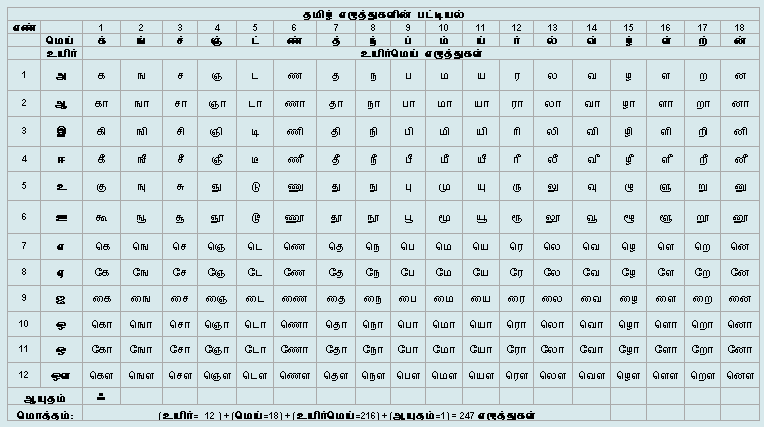

There are some lexical rules for formation of words. An overdot (see image) - equivalent to Devanagari sign virama - suppresses the inherent trailing a sound of the consonant sign - that is, it is a pure consonant. In every case the vowel symbol is different from the vowel standing alone. Some syllables are written by modifying the shape of the consonant in a way that is inherent to the vowel, others are written by adding vowel-inherent suffix to the consonant, yet others a prefix, and finally some vowels require adding both a prefix and a suffix to the consonant. However, the signs for the syllables are derived from that of the inherent consonant thus it is of the abugida type. The script is syllabic, in the sense that each letter is a syllable. This characterstic has partly to do with the fact that in ancient times, writing involved carving with a sharp point on palm leaves ( olaichuvadi) and it was apparently easier to produce curves than straight lines by this method. The script is sometimes called Vattezhuthu, literally "round writing". However, no such distinction is observed by modern Tamil speakers. Some scholars have suggested that in Sentamil (which refers to Tamil as it existed before Sanskrit words were borrowed), stops were voiceless when at the start of a word and unvoiced otherwise. Unlike Devanagari, Tamil has neither conjunct consonants nor aspirated and voiced stops. The consonants are classified into three categories with 6 in each category: vallinam - hard, mellinam - soft or nasal, and idayinam - medium. The vowels are divided into short and long (five of each type) and two dipthongs (ஐ and ஒள). But one cannot of course use any consonant without suffixing it with vowel!) Their supporting argument is that when a consonant is used with a vowel it is a separate letter. (The practise of taking the cartesian product of the vowels and consonants is widely seen. The Tamil alphabet has 12 vowels and 18 consonants. Writing direction: left to right in horizontal lines.In Tamil, there are 30 characters.When certain consonants occur together, special conjunct symbolsĪre used which combine the essential parts of each letter.When they appear at the beginning of a syllable, vowels are written as independent letters.Diacritics, which can appear above, below, before or after a consonant, are used to change the inherent vowel. Type of writing system: Abugida / Syllabic Alphabet in which all consonants have an inherent vowel.Kerala used to write Malayalam with the Syriac script and useĪ variety of Malayalam known as Suriyani Malayalam in their liturgy. Malaysia, and occasionally by Muslims in Kerala. Malayalam is also regularly written with a version of theĪrabic script by Muslims in Singapore and These changes are not applied consistently so the modern script is often a mixture of traditional and simplified letters. The main change involved writing consonants and diacritics separately rather than as complex characters. Or reformed version of the script was introduced during the 1970s andġ980s. Some changes were made to the alphabet over the following centuries, andīy the middle of the 19th century the Malayalam alphabet had attained itsĪs a result of the difficulties of printing Malayalam, a simplified By the early 13thĬentury it is thought that a systemised Malayalam alphabet had emerged. Was brought to the southwest of India in the 8th or 9th century and wasĪdapted to write the Malayalam and Tulu languages. Ī version of the Grantha alphabet originally used in the Chola kingdom The oldest known writing in Malayalam is known as the Edakal-5 inscription, is in the Vatteluttu alphabet, and dates from late 4th century or the early 5th century AD. Malayalam was first written with the Vatteluttu alphabet (വട്ടെഴുത്ത് Vaṭṭeḻuttŭ), which means 'round writing' and developed from the Brahmi script. Original the name referred to the land of the Chera dynasty (2nd century BC - 3rd century AD), which corresponds to modern Kerala and Tamil Nadu, and was later used to refer to the language.

The name Malayalam means "mountain region", and comes from mala (mountain) and alam (region). Malayalam is also known as Alealum, Malayalani, Malayali, Malean, Maliyad, Mallealle or Mopla. Status: statutory provincial language in Kerala, Lakshadweep and Mahé, Puducherry in India.Writing system: Malayalam and Arabic scripts (current), Grantha, Vatteluttu and several other scripts (past).Language family: Dravidian, Southern Dravidian, Tamil-Kannada, Tamil-Kodagu, Tamil-Malayalam.


 0 kommentar(er)
0 kommentar(er)
